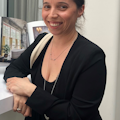It takes a village to do a lot of things, and building an extraordinary brand is no different. So how do you design a retail environment that not only does its job (selling product) but does it well?
By surrounding yourself with the right people, of course. There are a number of key players that should be included in every retail project, so we took the time to sit down with a few folks who know best, including interior designers, graphic designers and lighting specialists. We asked all participants the following questions:
How do you work with an interior designer to create a cohesive and strong brand presentation in a retail space?
What should you be bringing to the table?
The following are some of the highlights from their answers, which reveal exactly what they believe their roles are in the design process and what should be expected of them. But despite their varying disciplines, there is one thing they all make clear: their work should always reinforce the original brand concept.
the graphic designer
Nowadays, the space, information graphics and collateral are all intertwined. The elements feed off of each other during development and create an identity as a whole. When we work with an outside designer, it is essential for them to understand our vision so that the work is as seamless as possible. We start by sharing the background research related to the brand and our design ideas, and this establishes a strong foundation from which the graphic designs are built upon. We hope the graphic designer will have kept up with the ever-changing world of printing processes, materials and even signage. Understanding the full range of possibilities is key to selecting the best methods and format for each project.
the stylist/display specialist
It’s very important for anyone in that chain to understand the basic attributes of a brand. If not, it should be part of your own creative fact-finding. Is this an organic story? A modern story? An extension? A re-creation? It’s about really understanding the qualities of a brand (be it product or a hospitality story), then using props and making decisions to tell the story, visually.
A brand is often built elsewhere, in print and online, but has to manifest itself in three-dimensional ways, in a space, in a photo shoot. The other key is telling the story without overriding or upstaging it. The choices (of color, of material, of prop) should be supporting players. Very often, they’re subliminal, like the art direction of a film. The key is making those subliminal choices memorable.
In retail, the way the product is merchandised must also coincide with the initial branding strategy. The stylist is bringing in branding cues, in the way of props and the way product is presented. By working with the design team on the initial emotive images that represent the brand and drive the design, the stylist has a more cohesive viewpoint and strategy in producing the end results.
the lighting designer
We know our technical information about retail lighting—angles of light, floor to product ratios, wall ratios and what kind of lights work best on different products—but how we use them is crucial. Bright (think Uniqlo on one extreme) and dark (think Abercrombie on the other extreme) can be the beginning of the story.
Equally important is where the light comes from, which is how it defines the journey. We can create an experience from the second you see the drama in the window, pass the portal of entry and touch a product. Is the experience cool or warm? At Clinique, for example, we focus heavily on the vertical displays. Color is extremely important. They want a clean and crisp feeling, not medical. We achieve this by mixing warm light with great color rendering with cooler light for punch and contrast. We also have to soften the light in the store so the person looks good.
We bring the spark and reinforce the brand. We define the space and guide your attention like fish to a lure. Sometimes it’s simple, but it’s never easy.
We enjoy looking at various ways lighting design can achieve the desired brand identity. A thorough discussion involves where illumination needs to take place in the space beyond the ceiling plane. Often times, we receive a reflected ceiling plan and are asked to provide a lighting pattern layout. It may end there, but good lighting design considers the walls and the merchandise fixturing. We collaborate with the interior designer to integrate light fixtures properly into millwork details, perimeter sections and display fixtures. If there is a back-lit wall feature that happens to be the focal point of the space, we’ll advise on how best to place the lighting so it achieves the desired result and is maintainable for the retailer.
About the Author
AnnMarie Martin
Editor-in-Chief
AnnMarie is the former Editor in Chief of i+s and has been covering the commercial design space. Her style and vision has helped the brand evolve into a thought leader in purpose-driven design and cultural movements shaping the way we live and work.

